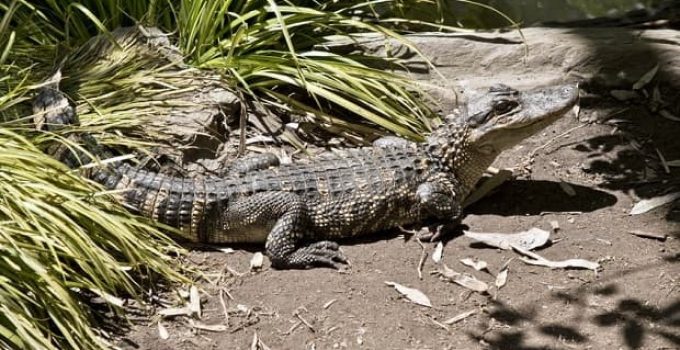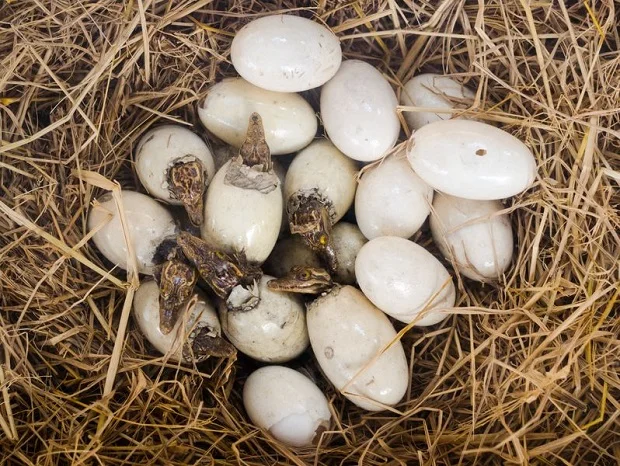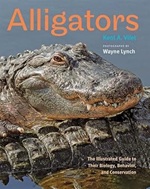How Long Do Alligators Live?
Answer at a Glance: If an alligator survives into adulthood, most estimates average the alligator lifespan to be 20-30 years in the wild and up to 50 years or more in captivity.
Dig Deeper
- Alligator Egg Mortality Statistics
- Hatchlings and Juveniles Mortality Statistics
- Average Lifespan of the Adult Alligator
- Oldest Alligator on Record
- References
Awareness of the mortality rate of alligators at different stages of development is crucial to understanding their average lifespan. Most alligators, unfortunately, do not survive into adulthood. Let’s take a closer look at the lifespan of alligators at each stage of life.
Alligator Mortality Rate Overview
These interesting statistics provided by the Florida Fish and Wildlife Conservation Commission clearly illustrate how few alligators actually mature to adulthood and survive to die of old age. The Commission estimates that a clutch size of 35 will produce 15 hatchlings. Sixty percent will not survive the year. Of the remaining 6, only four will reach maturity. [1]
Alligator Egg Mortality Statistics
After mating, the female alligator takes on the crucial role of protecting her eggs. She builds a nest and lays her eggs, which are collectively referred to as a clutch. The number of eggs can range from a few to over 50, depending on the health, age, and size of the alligator, with an average of 30-35 eggs. [1]
According to the Florida Fish and Wildlife Conservation Commission. An average of one-third of alligator nests will not make it through the incubation period. [2]
Several factors contribute to the loss of alligator eggs and the destruction of nests.
Once the female alligator has built her nest and laid her eggs, the incubation period begins, lasting approximately 65 days. During this vulnerable time, the nest is at risk of predation from various animals, with raccoons being the primary threat. [3]
It is challenging to calculate the number of nests destroyed nationwide accurately. But as a point of reference, a small four-year study in the 1970s at the Okefenokee National Wildlife Refuge found that predation accounted for 96% of the nest losses. [4]
Another threat to the alligator nest is flooding. The female alligator typically builds a nest near a water source at the beginning of the rainy season in June, making it vulnerable to flooding. [5]
Finally, to a lesser degree, some eggs are lost simply by the mother accidentally crushing them. [6]
Hatchlings and Juveniles Mortality Statistics
Of the surviving nests, the hatching rate in the wild is less than 70%, resulting in approximately 24 hatchlings per nest. [7]
Unfortunately, their survival rate is less than 50%, primarily due to predation, especially from larger alligators. Only about 10 will survive the first year, and this number drops to a mere five that will mature into adults. [8]
Average Lifespan of the Adult Alligator
The mortality rates up to adulthood give a clear picture of the percentage of alligators that are included in the alligator lifespan statistic. There are two sets of statistics for the mortality rate—those in the wild and those in captivity.
It is challenging to reasonably measure the lifespan of alligators in the wild because wild animals rarely live to reach their maximum possible age and cannot be recorded as accurately as those raised under captive conditions. Additionally, this area has not been studied extensively, and even the most authoritative sources provide widely varying estimates. [9]
Of the remaining alligators that have reached a ripe old age, most estimates average the alligator lifespan to be 20-30 years in the wild and up to 50 years or more in captivity. [10]
Oldest Alligator on Record
The Guinness Book of World Records lists Mujo, an alligator living at the Belgrade Zoo in Serbia, as the oldest alligator on record. As of May 2018, the American Alligator was at least 80 years and 252 days old and was still living. [11]
Previously, the oldest alligator was Cabulitis, an alligator from the Riga Zoo in Latvia, which lived to be 75 years old. [12]
References
- [1][7] SRAC Fact Sheet – “Alligator Production: Breeding, Egg Collection, Incubation, and Hatching.”
- [2][8] Florida Fish and Wildlife Conservation Commission – “Alligator Facts.”
- [3][6] Texas Parks and Wildlife – “Brazos State Park – Alligator Nest.”
- [4] Wendell D. Mellen, “Nesting Ecology of Alligators on the Okefenokee National Wildlife Refuge.” U. S. Fish and Wildlife Service, Okefenokee NWR, Waycross, GA
- [5] A. Kushlan and Marilyn S. Kushlan, “Water Levels and Alligator Nesting in the Everglades.” U.S. National Park Service, South Florida Research Center
- [9] The Wildlife Society – “35-Year Study Sheds New Light On Alligators’ Lifespan.”
- [10] University of Michigan-Animal Diversity Web – “Alligator Mississippiensis-Average Lifespan.”
- [11] Guinessworldrecords.com – “Oldest Living Alligator in Captivity.”
- [12] Fredericks, Anthony D. How Long Things Live. United States, Stackpole Books, 2010.
Related Products
Alligators: The Illustrated Guide to Their Biology, Behavior, and Conservation Hardcover – Illustrated
by Kent A. Vliet (Author), Wayne Lynch (Photographer)
In this fascinating account, richly illustrated with more than 150 photographs from award-winning wildlife photographer Wayne Lynch, expert zoologist Kent A. Vliet introduces readers to the biology, ecology, and natural history of the American alligator.




